历史
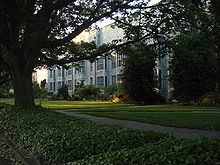
The Chemistry building, one of UBC's oldest, on a summer evening
Establishment of a provincial university
A provincial university was first called into being by the British Columbia University Act of 1908, although its location was not yet specified. The governance was modelled on the provincial University of Toronto Act of 1906 which established a bicameral system of university government consisting of a senate (faculty), responsible for academic policy, and a board of governors (citizens) exercising exclusive control over financial policy and having formal authority in all other matters. The president, appointed by the board, was to provide a link between the 2 bodies and to perform institutional leadership. The Act constituted a twenty-one member senate with Francis Carter-Cotton of Vancouver as Chancellor.
Before the University Act, there had been several attempts at establishing a degree-granting university with assistance from the Universities of Toronto and McGill. Columbian College in New Westminster, through its affiliation with Victoria College of the University of Toronto, began to offer university-level credit at the turn-of-the-century, but it was McGill that would come to dominate higher education in the early 1900s.
Building on a successful affiliation between Vancouver and Victoria high schools with McGill University, Henry Marshall Tory helped to establish the McGill University College of British Columbia. From 1906 to 1915, McGill BC (as it was called) operated as a private institution providing the first few years toward a degree at McGill University or elsewhere. The Henry Marshall Tory Medal was established in 1941 by Henry Marshall Tory (1864–1947), FRSC, founding President of the University of Alberta and of the National Research Council of Canada, and a co-founder of Carlton University.
In the meantime, appeals were again made to the government to revive the earlier legislation for a provincial institution, leading to the University Endowment Act in 1907, and The University Act in 1908. In 1910 the Point Grey site was chosen, and the government appointed Dr. Frank Fairchild Wesbrook as President in 1913. A declining economy and the outbreak of war in August 1914 compelled the University to postpone plans for building at Point Grey, and instead the former McGill University College site at Fairview became home to the University until 1925. The first day of lectures was September 30, 1915, the new university absorbing McGill University College. University of British Columbia awarded its first degrees in 1916.
Early years
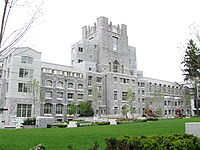
The UBC Vancouver school of theology was built in 1927.
World War I dominated campus life, and the student body was "decimated" by enlistments for active service, with three hundred UBC students in Company "D" alone. By the end of the war, 697 members of the University had enlisted. A total of 109 students graduated in the three war-time congregations, all but one in the Faculty of Arts and Science.
By 1920, the university had only three faculties: Arts, Applied Science, and Agriculture (with Departments of Agronomy, Animal Husbandry, Dairying, Horticulture and Poultry). It only awarded the degrees of Bachelor of Arts (B.A.), Bachelor of Applied Science (B.A.Sc.), and Bachelor of Science in Agriculture (B.S.A.). There were 576 male students and 386 female students in the 1920–21 winter session, but only 64 academic staff, including 6 women.
In the early part of the twentieth century, professional education expanded beyond the traditional fields of theology, law and medicine. UBC provided no degrees in these areas, but was beginning to offer degrees in new professional areas such as engineering, agriculture, nursing, and school teaching. Graduate training based on the German-inspired American model of specialized course work and the completion of a research thesis was introduced, with students completing M.A. degrees in natural sciences, social sciences, and humanities.
In 1922 the now twelve-hundred-strong student body embarked on a "Build the University" campaign. Students marched in the streets of Vancouver to draw attention to their plight, enlist popular support, and embarrass the government. 56,000 signatures were presented at legislature in support of the campaign, which was ultimately successful. On September 22, 1925, lectures began on the new Point Grey campus. Except for the Library, Science and Power House buildings, all the campus buildings were temporary constructions. Two playing fields were built by the students themselves, but the University had no dormitories and no social centre. Still, the University continued to grow steadily.
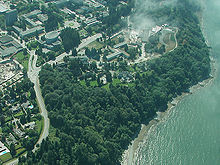
View of the north part of the Point Grey Campus.
Soon, however, the effects of the depression began to be felt. The provincial government, upon which the University depended heavily, cut the annual grant severely. In 1932–33 salaries were cut by up to 23%. Posts remained vacant, and a few faculty lost their jobs. Most graduate courses were dropped. In 1935, the University established the Department of Extension. Just as things began to improve, World War II broke out. Canada declared war on September 10, 1939. Soon afterwards, University President Klinck wrote:
From the day of the declaration of war, the University has been prepared to put at the disposal of the Government all possible assistance by way of laboratories, equipment and trained personnel, insofar as such action is consistent with the maintenance of reasonably efficient instructional standards. To do less would be unthinkable.
Heavy rains and melting snowfall eroded a deep ravine across the north end of the campus, in the Grand Campus Washout of 1935. The campus did not yet have storm drains, and surface runoff went down a ravine to the beach. When the University carved a ditch to drain flooding on University Avenue, the rush of water steepened the ravine and eroded it back as fast as 10 feet (3.0 m) per hour. The resulting gully eventually consumed 100,000 cubic yards (76,455 m), two bridges, and buildings near Graham House. The University was closed for 4½ days. Afterwards, the gully was filled with debris from a nearby landslide, and only traces are visible today.
Military training on the campus became popular, then mandatory. WWII marked the first provision of money from the federal government to the University for research purposes. By the end of the war, it became clear that the facilities at Point Grey had become totally inadequate to cater to the huge influx of veterans returning to their studies. The University needed new staff, new courses, new faculties, and new buildings for teaching and accommodation. The student population rose from 2,974 in 1944–45 to 9,374 in 1947–48. Surplus Army and Air Force camps were used for both classrooms and accommodation. Fifteen complete camps were taken over by the University in the course of the 1945–46 session alone, with a sixteenth camp situated on Little Mountain in Vancouver, converted into suites for married students. Most of the camps were dismantled and carried by barge or truck to the University where the huts were scattered across the campus. (A few huts remain in place today!)
Student numbers hit 9,374 in 1948; more than 53% of the students were war veterans in 1947–67. Between 1947 and 1951 twenty new permanent buildings were erected.
The single-university policy in the West was changed as existing colleges of the provincial universities gained autonomy as universities — the University of Victoria was established in 1963.
The University today
UBC's current president is Dr. Stephen Toope, appointed on July 1, 2006. He succeeds Dr. Martha Piper, who was the University's first female president and the first non-Canadian born president. The Chancellor of the University, who acts as the University's ceremonial head and sits on the academic Senate and the Board of Governors, is Sarah Morgan-Silvester (as of July 1, 2008). The UBC Okanagan campus is led by Dr. Doug Owram, Deputy Vice-Chancellor.
Governance and academics
The administration of UBC, as mandated by the University Act, is composed of a chancellor, convocation, board, senate, and faculties of the university . The Board of Governors is responsible for the management of property and revenue, while the Senate is vested with managing the academic operation of the university. Both are composed of faculty and students who are elected to the position. Degrees and diplomas are conferred by the convocation, which is composed of alumni, administrators, and faculty, with a quorum of twenty members. UBC also has a President, who is a chief executive officer of the university and a member of the Senate, Board of Governors, Convocation, and also serves as Vice Chancellor. The President of the University is responsible for managing the academic operation of the university, including recommending appointments, calling meetings of faculties, and establishing committees.
Faculties and Schools
Main article: Faculties and Schools of the University of British Columbia
UBC's academic activity is organized into "faculties", and "schools". Currently, UBC has twelve faculties and eleven schools on its Vancouver campus and seven faculties and two schools at its Okanagan campus . UBC Vancouver also has two academic colleges: Interdisciplinary Studies and Health Disciplines, while UBC Okanagan also has a College of Graduate Studies. At the Vancouver campus, the Faculty of Arts, which dates back to the 1915 Fairview Campus, is the largest faculty with twenty departments and schools. With the split of the Faculty of Arts and Science in 1964, the Faculty of Science is the second largest faculty with nine departments.
Enrolment
In 2003, UBC had 3,167 full-time 教职员工, and 4,612 non-faculty full-time employees. It had over forty thousand students (33,566 undergraduate students and 7,379 graduate students), and more than 180,000 alumni in 120 countries. Enrolment continues to grow (the numbers listed within the table are as of Nov 2008). The founding of the new Okanagan campus will increase these numbers dramatically. The university is one of only two Canadian universities to have membership in Universitas 21, an international association of research-led institutions (McGill University is the other).
Quality of education
| University rankings |
| ARWU World |
36 |
| ARWU N. America |
29 |
| ARWU Natural Science & Math |
53-76 |
| ARWU Engineering & CS |
51-77 |
| ARWU Life Sciences |
36 |
| ARWU Social Sciences |
29 |
| Newsweek World |
27 |
| THE-QS World |
40 |
| THE-QS Arts |
22 |
| THE-QS Life Sciences/Biomed |
16 |
| THE-QS Natural Sciences |
20 |
| THE-QS Social Sciences |
13 |
| THE-QS Engineering/Tech. |
17 |
| Canadian rankings |
| Maclean's Medical/Doctoral |
4 |
|
v • d • e
|
UBC consistently ranks as one of the top three Canadian universities by Research InfoSource and ranks as second in Canada and thirty-sixth in the world in the Academic Ranking of World Universities. In 2006, Newsweek magazine ranked the University of British Columbia second in Canada and 27th in the world. The Times Higher Education Supplement of the UK ranked UBC as second in Canada and thirty-third in the world in 2007. According to Maclean's University Rankings, UBC has the highest percentage of Ph. D level professors among all public universities in North America (92%). It has received widespread recognition by Maclean's and Newsweek magazines for its foreign language program; the Chinese program is North America's largest, and the Japanese program is North America's second largest (after the University of Hawaii). The Department of Art History, Visual Arts and Theory has been recognized consistently for the world-class artists who teach there. In 2003 the National Post stated UBC had the highest entrance requirements for undergraduate admission out of all universities in Canada.
Research centres and institutes
UBC, with a research budget among the top three among Canadian universities, runs many research centres and institutions. UBC operates the Bamfield Marine Sciences Centre on Vancouver Island for research biologists, ecologists and oceanographers. As a founding member of the Western Canadian Universities Marine Sciences Society, UBC maintains this field station on the west coast of Vancouver Island, which is jointly run by the University of Victoria, Simon Fraser University, the University of Alberta and the University of Calgary. The Peter Wall Institute for Advanced Studies is an interdisciplinary research institute for fundamental research in the Sciences, Social Sciences, and Humanities. The UBC Farm is a 24 hectare learning and research farm located in UBC's South Campus area is the only working farmland within the city of Vancouver. The farm features Saturday Farm Markets from early June until early October, selling organic produce and eggs to the community.
TRIUMF
Main article: TRIUMF
TRIUMF is Canada’s national laboratory for particle and nuclear physics located at UBC. The name was formerly an acronym for TRI-University Meson Facility, but TRIUMF is now owned and operated by a consortium of eleven Canadian universities. The consortium runs TRIUMF through a contribution of funds from the National Research Council of Canada, and makes TRIUMF’s facilities available to Canadian scientists and to scientists from around the world. TRIUMF also houses the world's largest cyclotron.
Aboriginal
The UBC’s Longhouse is a dedicated space for Aboriginal institutions, a “zone of comfort” for Aboriginal students and a focus for Aboriginal culture and activities on campus. UBC has an Associate Dean of Indigenous Education and offers degrees in First Nations Studies through a program in the Arts Faculty. The UBC’s First Nations Forestry Initiatives was developed in partnership with specific Aboriginal communities to meet specific needs within more remote Aboriginal communities. UBC also offers a Chinook Diploma Program in the Sauder School of Business. UBC also runs the Chinook Summer Biz Camp, which seeks fosters entrepreneurship among First Nations and Métis high school students. UBC hosts a Bridge Through Sport Program, Summer Science Program, Native Youth Program, and Cedar Day Camp and Afterschool Program. UBC has had success in recruiting and retaining Aboriginal faculty. UBC developed governing board and senate policies as well as Aboriginal governed councils within the university structure.
Finances
For 2006–2007, UBC had expected a $36 million deficit. With various cost cutting measures, the University posted a small surplus of $1.92 million. As of March 2007, UBC had assets of $3.2 billion and liabilities of $1.8 billion. Total revenue for 2006–2007 was $1.59 billion, of which 36% came from the provincial government, 11% from the federal government, 17% from "sales of goods and services", 18% from tuition, and 18% from all other sources. Total expenses were $1.50 billion, of which salaries, wages, benefits, and honoraria were 59%, office supplies and expenses were 12%, amortization was 9%, and all other expenses were 20%. Less than 1% of expenses went to fundraising.
Tuition
In 2001–02, UBC had one of the lowest undergraduate tuition rates in Canada, at an average of $2,181 CAD per year for a full-time programme. This was due to a government-instituted tuition freeze. In 2001, however, the BC Liberal party defeated the NDP in British Columbia and lifted the tuition freeze. In 2002–03 undergraduate and graduate tuition rose by an average of 30%, and by up to 40% in some faculties. This has led to better facilities, but also to student unrest and contributed to a teaching assistant union strike.
UBC again increased tuition by 30% in the 2003–04 year, again by approximately 15% in the 2004–05 season, and 2% in the 2005–06 and 2006–07 years. Increases were lower than expected because, in the 2005 Speech from the Throne, the government announced that tuition increases would be capped to inflation. Despite these increases, UBC's tuition remains below the national average and below other universities in the regions. In 2006–07, the Canadian average undergraduate tuition fee was $4347 and the BC average was $4960. UBC tuition for 2007–2008 is $4,257 for a Canadian student in a basic 30-unit program, though various programs cost from $3,406 to $9,640.
Tuition for international students is significantly higher (2.3–4.6 times higher than domestic students). In 2009, tuition for international students ranged from 16,245 CAD to 25,721 CAD.
Campuses and features
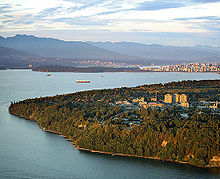
Aerial View of the Vancouver Campus
Vancouver
49°16′N 123°15′W / 49.267°N 123.25°W / 49.267; -123.25 The Vancouver campus is located at Point Grey, a twenty-minute drive from downtown Vancouver. It is near several beaches and has views of the North Shore mountains. The 7.63 km² Pacific Spirit Regional Park serves as a green-belt between the campus and the city. Buildings on the Vancouver campus currently occupy 1,091,997 m² gross, located on 1.7 km² of maintained land. The Vancouver campus' street plan is mostly in a grid of malls (for driving and pedestrian-only). Lower Mall and West Mall are in the southwestern part of the peninsula, with Main, East, and Wesbrook Malls northeast of them. Wireless Internet access is available at no charge to students, faculty, and staff inside and outside of most buildings at both campuses.
The University Endowment Lands are not within Vancouver's city limits, and as such UBC is policed by the RCMP rather than the Vancouver Police Department. However, the Vancouver Fire Department does provide service to UBC under a contract. Also, all postage sent to any building on campus includes Vancouver in the address. UBC Vancouver also has two satellite campuses within the City of Vancouver: a campus at Vancouver General Hospital for the medical sciences, and UBC Robson Square in downtown Vancouver for part-time credit and non-credit programmes. Moreover, UBC is also a partner in the consortium backing Great Northern Way Campus Ltd. UBC is affiliated with a group of adjacent theological colleges, which include the Vancouver School of Theology, Regent College, Carey College and the Corpus Christi College.
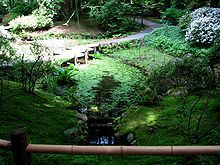
"Devil-losing bridge" and iris pond in Nitobe Memorial Garden
The campus is also home to numerous gardens. The UBC Botanical Garden and Centre for Plant Research, the first UBC department, holds a collection of over 8000 different kinds of plants used for research, conservation and education. The original site of the UBC botanical garden was at the "Old Arboretum". Today all that remains of it are trees planted in 1916 by John Davidson. The old arboretum is now home to many buildings including the First Nations House of Learning. The Nitobe Memorial Garden, built to honour Japanese scholar Inazo Nitobe, the garden has been the subject of more than fifteen years' study by a UBC professor, who believes that its construction hides a number of impressive features, including references to Japanese philosophy and mythology, shadow bridges visible only at certain times of year, and positioning of a lantern that is filled with light at the exact date and time of Nitobe's death each year. The garden is behind the university's Asian Centre, which is built from steel girders from Japan's exhibit at Osaka Expo.
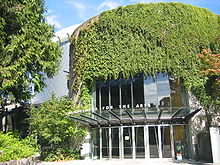
Chan Centre for the Performing Arts
The campus also features the Chan Centre for the Performing Arts: a performing arts centre containing the Chan Shun Concert Hall, Telus Studio Theatre and the Royal Bank Cinema. It is often the location of convocation ceremonies as well as the filming location for the 4400 Center on the television show The 4400, as well as the Madacorp entrance set on Kyle XY. It has also been featured as the Cloud 9 Ballroom in the re-imagined Battlestar Galactica (Season 1, Episode 11: Colonial Day). It has also been used in Stargate Atlantis (Season 2, Episode 5: Condemned), as well as in the first season of Reaper.
Kelowna
49°56′N 119°24′W / 49.933°N 119.4°W / 49.933; -119.4 The Kelowna campus, known as UBC Okanagan, is located on the former North Kelowna Campus of Okanagan University College, adjacent to the international airport on the north-east side of Kelowna, British Columbia. This campus offers undergraduate degrees in Arts, Science, Nursing, Education, Management and Engineering as well as graduate degrees in most of these disciplines. The Okanagan campus is experiencing a $450 million CDN rapid expansion with construction of several new residential, teaching and research buildings now underway.
Libraries
Main article: University of British Columbia Library
The UBC Library, which comprises 5.8 million books and journals, 5.3 million microforms, over 833,000 maps, videos and other multimedia materials and over 46,700 subscriptions, is the second largest research library in Canada. The libraries lent out over 2.5 million print works in 2008/2009 with over 2.9 million visits to the library (measured by gate counters). The library has twenty-one branches and divisions at UBC and at other locations, including three branches at teaching hospitals (St. Paul's Hospital, Vancouver Hospital and Health Sciences Centre, BC Children's Hospital), one at UBC's Robson Square campus in downtown Vancouver, and one at the new UBC Okanagan campus. Plans are also under way to establish a library at the Great Northern Way Campus on the Finning Lands.
The former Main Library has undergone construction and has been renamed the Irving K. Barber Learning Centre. The new library incorporates the centre heritage block of the old Main Library with two new expansion wings and features an automated storage and retrieval system (ASRS), the first of its kind in Canada.
Major General Victor Odlum CB, CMG, DSO, VD donated his personal library of 10,000 books, which has been housed in "the Rockwoods Centre Library" of the UBC library since 1963.
Student life
Student representation
Main article: Alma Mater Society of the University of British Columbia
UBC Vancouver students are represented by the Alma Mater Society, or AMS. The society's mandate is to improve the quality of educational, social, and personal lives of UBC students. The executive – composed of the President; Vice President, External Affairs; Vice President, Administration; Vice President, Finance; and Vice President, Academic and University Affairs – are responsible for lobbying the UBC administration on behalf of the student body, providing services, such as the AMS/GSS Health and Dental Plan, supporting and administering student clubs, and maintaining the Student Union Building (aka SUB) and the services it houses. Graduate Students are represented by the Graduate Student Society (GSS). Recently, the AMS has undertaken an initiative to construct a new Student Union Building (SUB) with a cost of $110 million, of which $80 million is paid by student fees, with 50% more space compared to the current SUB. Construction is slated to begin in 2012.
UBC Okanagan students are represented by The University of British Columbia Students' Union – Okanagan.

Orientation day for first year students at UBC Okanagan.
Student facilities
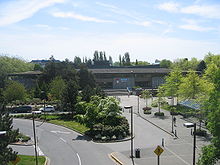
The Student Union Building (SUB).
The heart of student activity at UBC Vancouver is the centrally located Student Union Building, which houses offices of many clubs, half a dozen restaurants and cafés, a pub ("The Gallery"), a nightclub ("The Pit"), the inexpensive 425-seat Norman Bouchard Memorial Theatre ("The Norm Theatre"), several shops and a post office. The majority of the outlets and shops in the SUB are run by the AMS, however the addition of major corporate outlets in recent years by UBC Food Services has generated some controversy. The SUB Art Gallery contains mostly students' work. Beside the SUB, there is a small mound called The Grassy Knoll, which was constructed from the contents of the open pool dug near the Aquatic Centre. The Grassy Knoll was slated to be removed for the planned construction of an underground bus loop. However, on October 28, 2009, UBC was advised by Translink that due to its current funding levels it would not be able to provide funds for the construction of the bus loop. As a result, the bus loop project has been cancelled by the administration, although the rest of the renovations of the University Boulevard Neighbourhood are still under consideration.
Other student facilities on campus include the Ladha Science Student Centre, which was funded through a donation from Abdul Ladha, a levy from all Science undergraduate students, the VP Students, and the Dean of Science, and the Meekison Arts Student Space, which is located in the Faculty of Art's Buchanan D building.
Greek organizations
While UBC's Greek system is somewhat smaller than its counterparts in the United States, it does offer the largest and most active Greek system in Canada. There is a total of 18 Greek organizations. An InterFraternal Council (IFC) is recognized as a club by the Alma Mater Society and meetings of the fraternities under IFC occur at their respective fraternity houses each week. Greek life has its own division within UBC REC and intense competition between the 9 Fraternities for the title of top Athletic Fraternity occur. Alpha Delta Phi currently holds the title of IFC Intramural Champions.
The National Panhellenic Council (NPC) sororities on campus are overseen by the Panhellenic Council. All sororities have a chapter room in the Panhellenic House on Wesbrook Mall; the building also offers housing for 72 college women, with preference given to sorority members. Phrateres is not an official part of the Greek Organization on campus, but interacts with the fraternities on a similar basis as the sororities. Phrateres is an official AMS club and thus does not bar membership to male members, although it is strongly discouraged.
There are nine international fraternities on campus, the first of which was Alpha Delta Phi in 1926. However Alpha Delta Phi was preceded by several local fraternities on campus. Other fraternities include Alpha Epsilon Pi, Delta Kappa Epsilon, Psi Upsilon, Sigma Chi, Beta Theta Pi, Phi Delta Theta, Phi Gamma Delta, and Kappa Sigma.
Beta Theta Pi is the only fraternity on campus not in the Greek Village. They retained their own land on the old Fraternity Row which is closer to campus than the Greek Village. Alpha Epsilon Pi has no house, but plans are underway to provide them the lower level of the newly constructed Hillel House. The Greek Village shares a common underground parking lot and is managed jointly. All the houses on campus were constructed sometime between 2002 and 2003 including Beta Theta Pi. This came about as an agreement between many parties to sell the previous leased land to a development camp.
The seven sororities on campus include Alpha Delta Pi, Delta Gamma, Alpha Gamma Delta, Kappa Kappa Gamma, Alpha Phi, Gamma Phi Beta and Kappa Alpha Theta. The Panhellenic Total for UBC campus is 65, so each sorority has around that number of girls. Chapter meetings are held in the chapter's respective rooms each week and Greek-wide or campus-wide events are attended by members of all the sororities and fraternities. In the fall of 2010, an 8th sorority, Alpha Omicron Pi, will be re-colonizing at UBC campus.
Residences
According to a 2009 UBC Student Housing Study, UBC currently provides approximately 8680 beds on the Point Grey campus for an on-campus student population of about 11,000 people. The UBC administration has recognized the need for more student housing on campus, forecasting the need for 6400 new beds on campus within the next 20 years, and has expanded housing recently with the opening of the Marine Drive towers and the MBA house residence on South Campus.
Currently, there are two dormitory style residences on campus, primarily for first and second year students: Totem Park and Place Vanier. Totem Park, housing about 1163 students, consists of six dormitory buildings (Nootka, Dene, Haida, Salish, Kwakiutl, and Shuswap Houses), and a Commons Block (Coquihalla). All houses, except Shuswap, are co-ed, with alternating men's and women's floors. Shuswap house is currently the only house at Totem with co-ed floors (that is, men and women are allowed to live on the same floor).
Place Vanier, housing 1370 people, consists of 12 blocks constructed in 1959 (Robson House), 1960 (Okanagan, Sherwood Lett, Mackenzie, Ross, Hamber and Mawdsley Houses), 1961 (Kootenay House), 1968 (Cariboo and Tweedsmuir Houses), 2002 (Korea-UBC House) and 2003 (Tec de Monterrey-UBC House). The buildings vary from Male and Female only, to alternating gender floors, as well as fully mixed floors. The residences have both single and double rooms, with each floor having a lounge and communal bathrooms.
Older students, above the age of twenty, have several suite-style residence options on the Point Grey campus as well. The Gage Towers are a residence consisting of three 17-floor towers (North, South and East) primarily for second, third, and fourth year undergraduate students. Gage houses the most students and is closest to the Pit Pub. It consists of three interconnected towers (North, South, and East) as well as single student housing (both studio, and apartment) in a separate adjacent building. The towers are composed of "quads" which consist of 4 separate pods, each consisting of 6 individual bedrooms, a bathroom and a communal kitchen/dining area.
Adjacent to the Acadia Park residence area on the east part of campus is Fairview Crescent, a residence primarily for second and third year undergraduate students. Fairview also houses many graduate students. The residence consists of an L-Shaped pedestrian-only street lined with 4, 5 & 6 student (a mix of single-sex and co-ed) townhouses. The Beanery coffee shop is nestled in the middle of the residence.
The Thunderbird residences are primarily for graduate students and fourth year undergraduate students and are located at the southern edge of the academic core campus. The Ritsumeikan-UBC House is a residence with a Japanese cultural setting, named for Ritsumeikan University. Houses Japanese exchange students and Canadian students, who participate in unique inter cultural programmes. The residence's tatami room is used for practice sessions by the UBC Urasenke Japanese tea ceremony club. Two Canadian students are typically paired with two Japanese exchange students.
The newest addition to UBC Vancouver's student housing is the Marine Drive Residence, which is situated on the west side of campus slightly south of Place Vanier. The first phase, consisting of Building 1 (an 18-floor tower) and Building 2 (a 5 floor building commonly called the "Podium") opened Fall 2005, and is the most expensive residence on campus. In February 2006, the Board of Governors approved plans for the second phase of Marine Drive, finally putting an end to the debacle caused by concerns over the view of Wreck beach (Phase I's Building 1 was reduced from 20 floors to 18 because of this). Phase II consists of Buildings 4 through 6 (two towers and another "Podium", respectively), and also the Commonsblock. Buildings 4 through 6 were all open to students as of September 2008. A separate Commonsblock (the current Front Desk being located in building 1) was completed in summer 2009, and contains similar services to the Commonsblocks of other residences, such as exercise, game, and study rooms. Construction at Marine Drive was completed in February 2010, with the opening of a restaurant in building 4.
体育运动
UBC is represented in Canadian Interuniversity Sport by the UBC Thunderbirds. UBC is considering joining the NCAA Division II.
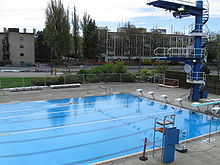
A swimming pool at the UBC National Swim Centre
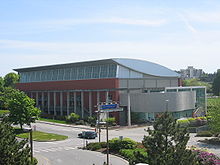
The Student Recreation Centre (SRC)
- UBC REC: UBC's intramural program is one of the largest in Canada, including various leagues and the year-ending Storm the Wall.
- Aquatic Centre: offers swimming pools indoors and outdoors. At designated times students can use the facility for free.
- Doug Mitchell Thunderbird Sports Centre: during final exam periods (December and April), hundreds of chairs and tables are placed inside for students to take examinations.
- There is a rock-climbing wall in the SUB, hidden behind the movie theatre screen, which is operated by the UBC Varsity Outdoor Club.
- The UBC Bike Hub, which houses the AMS Bike Co-op and the Bike Kitchen. The Bike Kitchen is a full service student-run non-profit bike shop, which also runs workshops and provides one-on-one instruction.
- The UBC Croquet Society plays friendlies during the week on various lawns and in front of the Koerner Library. Tournaments are held twice a semester.
- The Student Recreation Centre houses a gymnasium, sports equipment shop, dojo, and climbing wall, in addition to rooms for special exercise programmes.
- The neighbouring Pacific Spirit Regional Park has an extensive network of running trails. On the coast to the west of campus, the park includes Wreck Beach, one of the largest clothing-optional beaches in the world.
[edit] Fight song
Notable among a number of songs commonly played and sung at various events such as commencement and convocation, and athletic games are: "Hail, U.B.C" with words and music by Harold King and "High on Olympus" with words by D.C. Morton and music by J.C.F. Haeffner.
Campus events
A small number of large-scale, campus-wide events occur annually at UBC which are organized by university institutions, the AMS, and student constituencies of various faculties and departments. UBC Orientations organizes several events for first year students, such as Imagine UBC, GALA, and UBC Jump Start. Imagine UBC is an orientation day and pep rally for first-year undergraduate students that replaces the first day of September classes at UBC Vancouver.
Several athletic events take place at UBC every year. Storm the Wall is an intramural relay race put on by UBC REC in April, culminating in the climbing of a 12-foot (3.7 m) wall. It is one of the largest intramural events to take place regularly in Canada. Day of the Longboat is an intramural event put on at the end of September/early October by UBC REC. It is the largest voyageur canoe race in North America, with teams competing in a challenging 2km paddle around the waters of Jericho Sailing Centre.
Faculty constituencies, such as the Arts Undergraduate Society (AUS) and Science Undergraduate Society (SUS), hold events annually. Many of the major constituencies, such as for Arts, Science, and Engineering, hold their own faculty weeks to celebrate their faculties. The events may include keynote speeches, merchandise sales, and dances. Arts County Fair was an annual concert and party on the last day of classes in April, put on by the AUS and occurring at Thunderbird Stadium. Past headliners have included Sam Roberts, The New Pornographers, and Metric. Due to increasing financial difficulties (mostly resulting from mounting security and related costs) the AUS announced they would not continue the event in 2008. In its place, the Alma Mater Society of UBC hosted the AMS Block Party to celebrate the end of classes.
Additionally, a number of unofficial 'traditions,' exist at UBC: jumping from the UBC Aquatic Centre's outdoor 10-metre diving board late at night; and frequent repainting of the Engineering cairn, refashioning its large red-and-white 'E' into other letters representative of other faculties, clubs, and groups.
Student media
- The Ubyssey, a twice-weekly student newspaper that serves the Vancouver campus. 建立于 in 1918.
- "The Phoenix" is a biweekly student newspaper that serves the Okanagan campus. 建立于 in 1989 at Okanagan University College.
- The Graduate, a monthly magazine of news, opinion, and humour, by graduate students.
- Discorder ("That magazine from CiTR"), a music and entertainment magazine produced by the campus radio station.
- CiTR "Thunderbird Radio", the campus radio station.
- "The Knoll" is an alternative, politically progressive student publication that serves the Vancouver campus. 建立于 in 2006.
- The Point, a weekly student paper of athletics, clubs, and what's happening at UBC.
- The Underground, a satirical newspaper of the Arts Undergraduate Society with a vibrant arts and culture section, The Grounder.
- The 432 (website), a satirical, biweekly publication of the Science Undergraduate Society. 建立于 1987.
- The Cavalier (website), the official humour and events paper of the Commerce Undergraduate Society (CUS).
- The nEUSpaper , a humorous, biweekly publication of the Engineering Undergraduate Society, or EUS.
- Perspectives (website), British Columbia's first English-Chinese student newspaper.
- PRISM international (website), a quarterly literary magazine published by graduate students in the UBC Creative Writing Program.
- Cinephile (website), a biannual, peer-reviewed scholarly journal published by graduate students in the UBC Film Studies Program.
Notable people
See also: List of University of British Columbia alumni
Rhodes Scholars
- Jack Davis 1939
- John Turner 1949
Recipients of honorary degrees
- The 14th Dalai Lama
- Louise Arbour, Justice
- Rosemary Brown, first black Canadian woman elected to a provincial legislature
- Emily Carr, Artist
- Raffi Cavoukian, Musician
- Robertson Davies, Author
- John Diefenbaker, 13th Prime Minister of Canada
- David A. Dodge, Economist
- Tommy Douglas, former Premier of Saskatchewan
- Shirin Ebadi, Lawyer
- Atom Egoyan, Filmmaker
- Judith Forst, Mezzo-soprano
- Michael J. Fox, Actor
- Mike Harcourt, former Premier of British Columbia
- Ben Heppner, Operatic tenor
- Clara Hughes, Olympic cyclist and speedskater
- Finn E. Kydland, Economist
- Grace McCarthy, former premier of British Columbia
- Beverley McLachlin, first Woman to be Chief Justice of Canada
- Lester B. Pearson, 14th Prime Minister of Canada and winner of the Nobel Peace Prize
- Oscar Peterson, Jazz Pianist
- Bill Reid, Artist
- Carol Shields, Author
- Adlai Stevenson, former United States Ambassador to the United Nations
- Pierre Trudeau, 15th Prime Minister of Canada
- John Turner, 17th Prime Minister of Canada
- Archbishop Desmond Tutu
- George Woodcock, anarchist philosopher and founding editor of Canadian Literature (journal)
- Muhammad Yunus, founder of the Grameen Bank and winner of the Nobel Peace Prize
Notable faculty (former and current)
- Joel Bakan, creator of The Corporation
- Neil Bartlett, prepared the first known noble gas compound
- Sara Davis Buechner, pianist, recording artist, Koch International
- Brian Burke, former General Manager of the Vancouver Canucks
- Kim Campbell, former Canadian Prime Minister
- Meryn Cadell, writer and performance artist
- Hans G. Dehmelt, Nobel laureate in Physics in 1989
- Arthur Erickson, architect
- James Fankhauser, conductor
- John Friedmann, urban theorist
- Steven Galloway, novelist and playwright
- Michael Ignatieff, academic and Canadian politician
- Daniel Kahneman, Nobel laureate in Economic Sciences in 2002
- Dale Kinkade, linguist and specialist on Salishan languages
- Har Gobind Khorana, Nobel laureate in Medicine in 1968
- Peter W. Klein, Emmy Award winning journalist and filmmaker
- Larissa Lai, Canadian writer
- Ken Lum, noted Canadian artist. Represented Canada at the Sydney Biennale, the São Paulo Art Biennial, the Shanghai Biennale and at Documenta XI
- Pat McGeer, neuroscientist and politician
- Beverley McLachlin, Chief Justice of the Supreme Court of Canada
- Peter Oberlander, Canada's first professor of urban and regional planning and founder of UBC's School of Community and Regional Planning
- Daniel Pauly, fisheries scientist
- Richard J. Pearson, archaeologist and gardener
- Barbara Pentland, composer
- Randy Raine-Reusch, composer and ethnomusicologist
- William Rees, planning professor and originator of the ecological footprint
- Leonie Sandercock, urban theorist
- Michael Smith, Nobel laureate in Chemistry in 1993
- George F.G. Stanley, Canadian historian, designer of Canadian flag, Lieutenant-Governor of New Brunswick
- David Suzuki, biologist
- Bill Unruh, physicist, discoverer of the Unruh effect
- Erich Vogt, physicist
- Rudolf Vrba, Holocaust survivor and pharmacologist
- Jeff Wall, Noted photographer. Tate Gallery Retrospective, MOMA, Hasselblad Award, key figure in the photoconceptualist Vancouver School
- Carl E. Wieman, Nobel laureate in Physics in 2001
- Catherine Dauvergne, holds the Canada Research Chair in Migration Law
Chancellors and presidents
Main articles: List of Chancellors of the University of British Columbia and List of Presidents of the University of British Columbia
In the Media
Due to the fact that Vancouver, Canada is often the production location for numerous North American TV shows and films, the UBC campus (mainly the Point Grey campus) has also been featured in various TV shows and/or films, including: The Butterfly Effect, Fringe, She's The Man, X-Men Origins: Wolverine, and many others.
更多
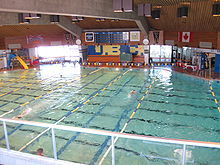
The indoor UBC Aquatic Centre pool.
- University Endowment Lands
- Regent College
- Bamfield Marine Sciences Centre
- List of universities in British Columbia
- Higher education in British Columbia
- Education in Canada
- List of Canadian universities by endowment
- Canadian Interuniversity Sport
- Canadian government scientific research organizations
- Canadian university scientific research organizations
- Canadian industrial research and development organizations
- CITR
Notes
- ^ UBC Financial Statements, March 31, 2009, page 12 – accessed from: [1].
- ^ UBC welcomes 7,400 new first-year students
- ^ http://www.thecanadianencyclopedia.com/index.cfm?PgNm=TCE&Params=U1SEC895855 School Song
- ^ "UBC Facts and Figures". University of British Columbia Public Affairs. 2008. http://www.publicaffairs.ubc.ca/services-for-media/ubc-facts-figures/. Retrieved 2010-01-26.
- ^ About UBC
- ^ http://www.qp.gov.bc.ca/statreg/stat/U/96468_01.htm University Act
- ^ http://www.legis.gov.bc.ca/37th5th/3rd_read/gov60-3.htm University Amendment Act, 2004
- ^ Dunae, P.A. (Ed.). (2003). 100 Years of Advanced Education, 1901-2001: Higher Education and Advanced Teacher Training in British Columbia. Retrieved June 1, 2008, from http://records.viu.ca/homeroom/content/postsec/postsec.htm
- ^ ShanghaiRanking Consultancy. "Academic Ranking of World Universities 2009". http://www.arwu.org/ARWU2009.jsp. Retrieved 2010-05-03.
- ^ Newsweek International. "The Top 100 Global Universities". http://www.msnbc.msn.com/id/14321230/print/1/displaymode/1098/. Retrieved 2010-05-03.
- ^ University of British Columbia (2008-08-22). "UBC: Our Place Among the World's Best". http://www.ubc.ca/global/index.html. Retrieved 2008-09-22.
- ^ http://www.topuniversities.com/university/70/university-of-british-columbia
- ^ "UBC Library Facts & Figures". University of British Columbia. 2009-01-06. http://www.library.ubc.ca/pubs/factfig.html. Retrieved 2009-09-28.
- ^ "The Canadian Encyclopedia". Thecanadianencyclopedia.com. http://www.thecanadianencyclopedia.com/. Retrieved 2008-10-06.
- ^ "Henry Marshall Tory, A Biography", originally published 1954, current edition January 1992, E.A. Corbett, Toronto: Ryerson Press, ISBN 0-88864-250-4
- ^ http://www.library.ubc.ca/archives/enrolmnt.html
- ^ Williams, M. Y. (Winter 1966). "The Grand Campus Washout" (PDF). UBC Alumni Chronicle 20 (4): 9–11. http://www.library.ubc.ca/archives/pdfs/chronicle/AL_CHRON_1966_4.pdf. Includes several contemporary photos of the Washout.
- ^ University of British Columbia (2008-04-14). "Corporate Director and Community Volunteer Elected UBC Chancellor; New Board Members Named". Press release. http://www.publicaffairs.ubc.ca/media/releases/2008/mr-08-040.html. Retrieved 2008-04-16.
- ^ "University Act". Laws of British Columbia. Queen's Printer. 05 August 2009. http://www.qp.gov.bc.ca/statreg/stat/U/96468_01.htm. Retrieved 18 August 2009.
- ^ "Faculties & Schools". University of British Columbia. http://www.ubc.ca/academic/fac_schools.html. Retrieved October 20, 2009.
- ^ "Universitas 21 Member List". Universitas 21. http://www.universitas21.com/memberlist.html. Retrieved 2010-02-02.
- ^ "Academic Ranking of World Universities". Institute of Higher Education, Shanghai Jiao Tong University. 2008. http://www.arwu.org/rank2008/EN2008.htm. Retrieved 2009-01-04.
- ^ "Top 100 North & Latin American Universities". Institute of Higher Education, Shanghai Jiao Tong University. 2008. http://www.arwu.org/rank2008/ARWU2008_TopAmer(EN).htm. Retrieved 2009-01-04.
- ^ "Top 100 world universities in Natural Sciences and Mathematics". Institute of Higher Education, Shanghai Jiao Tong University. 2008. http://ed.sjtu.edu.cn/ARWU-FIELD2008/SCI2008.htm. Retrieved 2008-02-19.
- ^ "Top 100 world universities in Engineering/Technology and Computer Sciences". Institute of Higher Education, Shanghai Jiao Tong University. 2008. http://ed.sjtu.edu.cn/ARWU-FIELD2008/ENG2008.htm. Retrieved 2008-02-19.
- ^ "Top 100 world universities in Life and Agriculture Sciences". Institute of Higher Education, Shanghai Jiao Tong University. 2008. http://ed.sjtu.edu.cn/ARWU-FIELD2008/LIFE2008.htm. Retrieved 2008-02-19.
- ^ "Top 100 world universities in Social Sciences". Institute of Higher Education, Shanghai Jiao Tong University. 2008. http://ed.sjtu.edu.cn/ARWU-FIELD2008/SOC2008.htm. Retrieved 2008-02-19.
- ^ "Top 100 Global Universities". Newsweek International. 2006. http://www.msnbc.msn.com/id/14321230/print/1/displaymode/1098/. Retrieved 2009-02-25.
- ^ "World University Rankings". Times Higher Education-Quacquarelli Symonds. 2008. http://www.timeshighereducation.co.uk/hybrid.asp?typeCode=243&pubCode=1&navcode=137. Retrieved 2008-12-31.
- ^ "THE-QS Top Universities Rankings: Arts and Humanities". Times Higher Education-Quacquarelli Symonds. 2008. http://www.topuniversities.com/worlduniversityrankings/results/2008/subject_rankings/arts_humanities/. Retrieved 2008-02-25.
- ^ "THE-QS Top Universities Rankings: Life Sciences and Biomedicine". Times Higher Education-Quacquarelli Symonds. 2008. http://www.topuniversities.com/worlduniversityrankings/results/2008/subject_rankings/life_sciences_biomedicine/. Retrieved 2008-02-25.
- ^ "THE-QS Top Universities Rankings: Natural Sciences". Times Higher Education-Quacquarelli Symonds. 2008. http://www.topuniversities.com/worlduniversityrankings/results/2008/subject_rankings/natural_sciences/. Retrieved 2008-02-25.
- ^ "THE-QS Top Universities Rankings: Social Sciences". Times Higher Education-Quacquarelli Symonds. 2008. http://www.topuniversities.com/worlduniversityrankings/results/2008/subject_rankings/social_sciences/. Retrieved 2008-02-25.
- ^ "THE-QS Top Universities Rankings: Technology". Times Higher Education-Quacquarelli Symonds. 2008. http://www.topuniversities.com/worlduniversityrankings/results/2008/subject_rankings/technology/. Retrieved 2008-02-25.
- ^ "Medical Doctoral Ranking". Maclean's. 2008. http://oncampus.macleans.ca/education/wp-content/uploads/2008/11/med.pdf. Retrieved 2009-01-04.
- ^ "ResearchInfoSource Top 50". http://www.researchinfosource.com/top50.shtml.
- ^ "NOTE: The Web version, unlike the print version of the rankings, fails to take ties into account and therefore places UBC incorrectly at 31st." "Newsweek Top 100 Global Universities". http://www.msnbc.msn.com/id/14321230/.
- ^ Queen's University's 'back door' is in England: Easier to gain admission to campus at 15th-century castle, Heather Sokoloff, National Post, June 5, 2003
- ^ ". The University of Winnipeg" (PDF). http://www.uwinnipeg.ca/index/cms-filesystem-action?file=pdfs/conferences/2007/aboriginal-rt-spring-report.pdf. Retrieved 2008-10-06.
- ^ UBC Financial Statements, March 31, 2007
- ^ Canada Revenue Agency, Charities Directorate. "Registered Charity Information Return for "University of British Columbia"". Registered Charities listings. Government of Canada. http://www.cra-arc.gc.ca/ebci/haip/srch/sec/SrchInput05Render-e;jsessionid=GfkvSbvQ0pwsXfp0DQ179PvvpzpqPWPlVvRhQJPn2FQy4ZmM38vx!2042349421?bn=108161779RR0001&fpe=2006-03-31&formId=19&name=UNIVERSITY+OF+BRITISH+COLUMBIA. Retrieved 2007-04-13. This link returns search results with links to UBC tax returns for the last few years. It is a query within the Canada Revenue Agency website. It may not work every time. If it does not, try again, or search the Charities Directorate main page (see reference below) for "University of British Columbia".
- ^ Canada Revenue Agency, Charities Directorate. "Charities Directorate main page". Registered Charities listings. Government of Canada. http://www.cra-arc.gc.ca/tax/charities/menu-e.html. Retrieved 2007-04-13. This page allows you search for tax returns from any Canadian registered charity. To find the UBC tax return, search for "University of British Columbia".
- ^ Premier of British Columbia (2005-02-08). "British Columbia to limit tuition increases". http://www2.news.gov.bc.ca/nrm_news_releases/2005OTP0017-000120.htm. Retrieved 2007-09-03.
- ^ Stats Canada (2006-09-01). "The Daily". http://www.statcan.ca/Daily/English/060901/d060901a.htm. Retrieved 2007-09-03.
- ^ Tuition & student fees
- ^ "Welcome to UBC Wireless". http://www.wireless.ubc.ca/.
- ^ "UBC Library History". University of British Columbia. 2005-07-26. http://www.library.ubc.ca/home/lib-history.html. Retrieved 2009-01-25.
- ^ The 4440, locations, IMDb
- ^ Colonial Day, locations, IMDb
- ^ "UBC Okanagan campus website". http://web.ubc.ca/okanagan/welcome.html.
- ^ "About the Library". http://www.library.ubc.ca/home/about.html. Retrieved 2010-02-02.
- ^ "Report of the UBC Librarian to the Senate". University of British Columbia Library. 2009. http://www.library.ubc.ca/home/UBC_RS_2009_fa.pdf. Retrieved 2009-02-02.
- ^ UBC Public Affairs (2008-04-11). "UBC Opens $79.7M Irving K. Barber Learning Centre". Press release. http://www.publicaffairs.ubc.ca/media/releases/2008/mr-08-043.html. Retrieved 2008-05-08.
- ^ "Open Letter to the UBC Vancouver Community". Office of the Associate Vice President, University of British Columbia Campus and Community Planning. 2009-10-28. http://www.publicaffairs.ubc.ca/2009/10/28/open-letter-to-the-ubc-vancouver-community/. Retrieved 2010-01-26.
- ^ [2]
- ^ "UBC Sororities | get involved. UBC". Ubcsororities.com. http://www.ubcsororities.com. Retrieved 2008-10-06.
- ^ "Home – Gamma Omicron Chapter of Beta Theta Pi". Betaubc.ca. http://www.betaubc.ca/. Retrieved 2008-10-13.
- ^ "UBC Student Housing Demand Study". UBC Planning. 2009-12. http://www.planning.ubc.ca/news_events/whats_new/articles263.php. Retrieved 2010-01-26.
- ^ "UBC expects visit by NCAA". Canada.com. http://www.canada.com/vancouver/theprovince/news/sports/story.html?id=4bcb77e5-b379-4e18-8a33-578138b9eba7. Retrieved 2008-10-06.
- ^ "NCAA Division II Consultation". University of British Columbia. http://www.students.ubc.ca/ncaa/. Retrieved 2008-10-19.
- ^ "Fight Songs". The Canadian Encyclopedia. http://www.thecanadianencyclopedia.com/index.cfm?PgNm=TCE&Params=U1SEC895855. Retrieved October 20, 2009.
- ^ http://www.gothunderbirds.ca/pdfs/MC_brochure08.pdf Retrieved on 2009-03-22
参考文献
- William A. Bruneau, 'A Matter of Identities: A History of the UBC Faculty Association, 1920–1990'. Vancouver: University of British Columbia Faculty Association, 1990.
- William A. Bruneau "Toward a New Collective Biography: The University of British Columbia Professoriate, 1915–1945." Canadian Journal of Education 19, no. 1 (Winter 1994).
- Michiel Horn."Under the Gaze of George Vancouver: The University of British Columbia and the Provincial Government, 1913–1939." BC Studies 83 (Autumn 1989).
- William C. Gibson 'Wesbrook & His University' (Vancouver: University of British Columbia Press)
- H.T. Logan, 'Tuum Est: A History of the University of British Columbia.' Vancouver: University of British Columbia, 1958.
- Lee Stewart. "It's Up to You": Women at UBC in the Early Years. Vancouver: University of British Columbia Press, 1990.
- George Woodcock & Tim Fitzharris. 'The University of British Columbia – A Souvenir'. (Toronto: Oxford University Press, 1986).
External links
 |
Wikimedia Commons has media related to: University of British Columbia |
 |
Wikinews has related news: University study finds U.S. defense contract information in 'electronic waste' in Africa |
- The University of British Columbia
- Association of Universities and Colleges of Canada Profile



